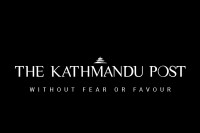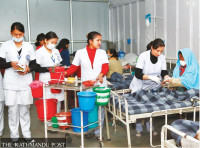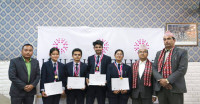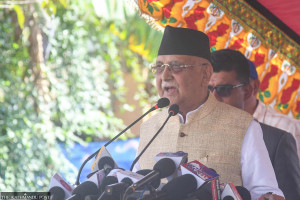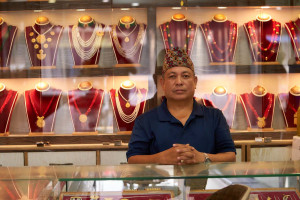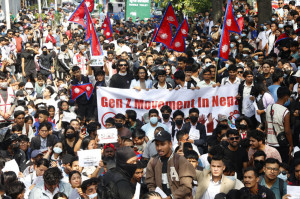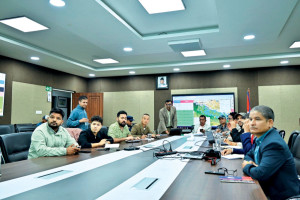Miscellaneous
Modi’s trans-Himalayan link to bring Nepal, India, China together
Indian Minister for External Affairs Sushma Swaraj arrived in Kathmandu on Friday in a bid to give Nepal-India ties a new economic footing.
Akhilesh Upadhyay
Swaraj’s Nepal visit, her second foreign trip after visiting Bangladesh in June, continues to underscore the Narendra Modi government’s emphasis on ‘neighbour-first’ diplomacy. Modi’s own visit to Nepal, scheduled for August 3-4, will be his third trip since he took office—after Bhutan and Brazil, where he attended the BRICS gathering.
Swaraj is expected to set the tone for Modi’s ‘pragmatic diplomacy’, whose core focus will be economic prosperity with an eye on greater regional integration. Modi’s Nepal outing will mark a step toward his broader ambition for high growth for India, where Nepal’s development fits neatly into trans-Himalayan regionalism fuelled by stronger connectivity.
It is likely that commercial interests will be paramount, trumping the age-old diplomatic rhetoric of South Asian bhai-bhai and ‘special relationships’. Modi’s arrival will also mark the assertion of ‘political ties’, a departure from Nepal-India relations that, of late, have been dominated by bureaucracy and security agencies.
“At the heart of Modi’s Nepal policy will be economic prosperity,” says Amresh Kumar Singh, a Nepali Congress lawmaker, who had a 20-minute meeting with Modi in Delhi in June. “His emphasis on greater connectivity with Nepal and China is strong.”
A potential game-changer
The last Indian prime minister who advocated greater engagement with the region was Inder Kumar Gujral. Gujral warmed Nepali hearts during his 1997 visit when he emphasised that New Delhi should not look for reciprocity from its smaller neighbours. However, Gujral was seen as a well-meaning political weakling and his efforts did not go very far. His mandate was narrow and his legacy short-lived. Since then, Nepal-India relations have been marked with the inevitability of asymmetry, mutual suspicions and unease.
Nonetheless, it is clear that there are major differences between Gujral and Modi. For one, Modi is seen as a potential game-changer, who is perhaps the first Indian prime minister in recent memory with the capacity to take on the Indian security and business establishments. Modi’s foreign policy approach is so ambitious that some believe it has the potential to transform the Nepal-India relationship. There is a chance that Nepal will finally be able to leverage its strategic location between the world’s two fastest growing big economies to its benefit.
“Modi was elected as prime minister on the economic plank of investment and prosperity,” says Bhekh Bahadur Thapa, former ambassador to India. “Since his election as prime minister, Modi has pursued a broader foreign policy agenda, which makes him the undisputed leader of the region. The time has now come for us to pursue joint venture investments and trade liberalisation in the region with new openness.”
But Thapa also mentions how New Delhi, in 1998, rolled back provisions in the bilateral trade treaty and opted for ‘regimented trade’ in face of opposition from business lobbies in Uttar Pradesh and Bihar. A similar challenge to Modi’s plans by vested interest groups could still occur.
“Modi, just like Gujral 17 years ago, talks about trade, commerce and investment and openness, but it remains to be seen how Modi’s vision for a prosperous neighbourhood and mutual benefits will play out in the days ahead,” cautions Thapa.
Beyond rhetoric
By all indications, Modi’s regionalism seems more enduring for the simple reason that it is based on mutual economic benefits and not merely on vague rhetoric about South Asian brotherhood. In addition, Modi also sees China as an integral partner in the game.
China’s Ambassador in New Delhi, Wei Wei, recently proposed trans-border cooperation with India under the Trans-Himalayan Economic Growth Region. This path-breaking regional initiative will be led by China and India.
“Instead of being defensive, Delhi must seek more details on this very interesting idea and offer a vision of its own for productive engagement with Beijing all across the Tibetan frontier,” writes C Raja Mohan in his column for the Indian Express (‘Chinese takeaway: Panchasheel blues,’ June 25, 2014, ).
Raja Mohan was in Kathmandu early this week addressing two public forums, one of them organised by the Centre for South Asian Studies headed by Nischal Nath Pandey.
“He [Raja Mohan] spoke about the need for better connectivity in the region,” says Pandey. “China is building so many roads and rail networks around the region that India is forced to make this policy change.”
Under Modi, expansion of rail and road networks will remain India’s top infrastructure priority, as much as already evident from the new budget.
Modi is the first Indian prime minister to invite South Asian neighbours in the swearing-in; he has firmly placed Bhutan, Bangladesh and now Nepal on his foreign policy road map. China’s foreign minister Wang Yi visited Delhi soon after Modi was sworn in. “I do see Modi as a game changer,” says Pandey.
Towards regionalism
Delhi and Beijing are likely to expedite modernising the infrastructure at the Nathu La, a pass connecting Tibet and Sikkim, and initiate full-fledged trade. They could also find ways to expand the current limited opportunities for Hindu and Buddhist pilgrims who want to visit places of worship on both sides of the border and Indian access to the holy sites of Kailash Manasarovar, suggests Raja Mohan.
Under the trans-Himalayan regionalism, both India and China are keen to have stronger North-South connectivity through Nepal, something the Indian security establishment has been resistant to for years. This will vastly enhance access to and from China to the Hindi speaking heartland of India in UP and Bihar.
UP and Bihar is Modi’s core constituency, where he swept the 2014 elections, and Modi sees Nepal as an important player in that China-Nepal-UP/Bihar connectivity.
For Modi, the crown jewel in regional connectivity would be a railway link between Pashupatinath and Banaras. “Granted, this is a long way off,” says Singh. “But Modi is a dreamer and this could be his dream project.”




 19.12°C Kathmandu
19.12°C Kathmandu

